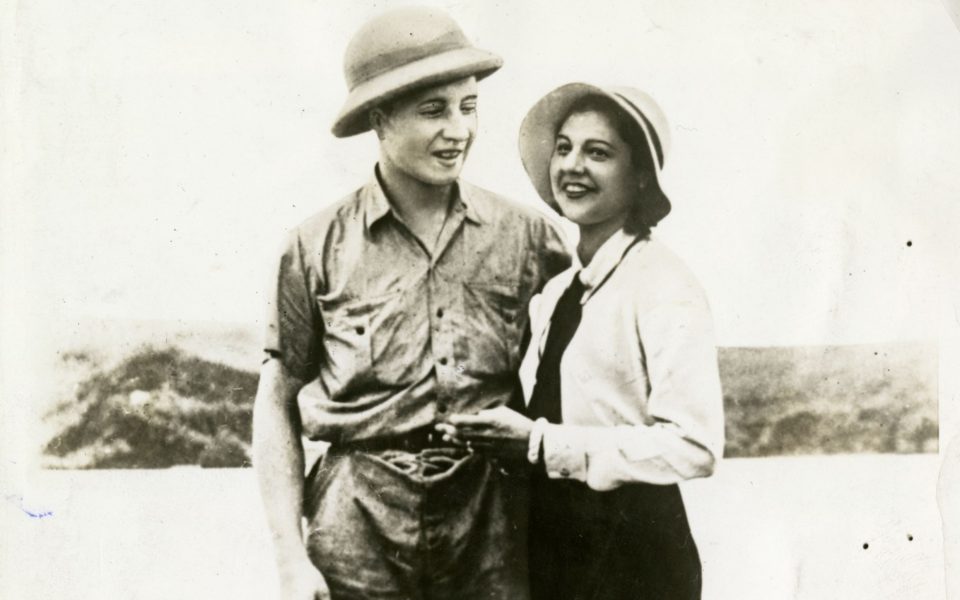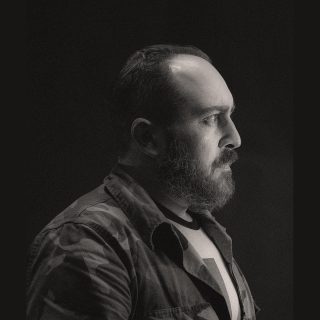Featured photo: Zachary Smith Reynolds and Libby Holman, cropped (photo courtesy Liam Donnelly Archive)
The terminal at the small airport just outside of downtown Winston-Salem houses a small shrine dedicated to its namesake. Inside, a stained-glass mural bathes the room in a cool, blue glow, displaying the seal of Forsyth County surrounded by aircraft of various eras and a map of the landing strip. Just opposite, a stern-faced bust of a young man casually regards each passerby. The inscription framing the bronze bust is short but boasts of remarkable bonafides.
A pilot’s license at 16, signed by Orville Wright. Youngest transport pilot in the United States. A London to China run in an 80 HP Amphibian aircraft in 1931.
“This terminal building of Smith Reynolds Airport perpetuates the interest of Zachary Smith Reynolds in Aviation,” frames the bust.
“1911-1932” reads just below.
In 1932, Zachary Smith Reynolds, the youngest son of the deceased tobacco baron Richard Joshua Reynolds, died of a gunshot wound he received late at night after a soirée held on the grounds of the Reynolda House estate in Winston-Salem.
Straight out of an Agatha Christie novel, his death was surrounded by speculation and sensationalism, especially when his wife Libby Holman was charged with his murder alongside Reynold’s best friend Ab Walker as an accomplice.
Holman, a popular torch singer famous in her own right, had recently married Reynolds and the result thrust the couple into the national spotlight. The media storm reached a peak when charges were abruptly dropped for both Holman and Walker months later.
Now, the mystery surrounding Reynolds’ death is on display at the Reynolda House as part of their new exhibit, Smith and Libby: Two Rings, Seven Months, One Bullet, on display through the end of the year.
Among the displays are relics of Smith and Libby’s life before, during and after Reynolds’ notorious death.
Only 21 at the time, Smith Reynolds was already a remarkable name in the world’s burgeoning aviation industry. Just six years younger than aviation contemporary Howard Hughes, Reynolds seemed destined for similar glory in an area that attracted well-funded risk-takers who wanted to make their own marks in life and history.

A 1932 newsreel, unearthed from archives and digitized for the exhibit, shows remarkably detailed footage of Winston-Salem, Reynolda House and interviews with investigators, namely Sheriff Transou Scott.
Scott, whose hurried diagram of the murder scene is displayed in the exhibit, amassed evidence that suggested it wasn’t just a cut-and-dried suicide. Some of that evidence is on display, including bullets from the Mauser pistol used in the shooting, a door that had a bloodstained handprint and testimony transcripts available via QR codes.

While the death of Reynolds is center stage of the exhibit, there are remarkable possessions of Reynolds also on display.
His wallet, with multiple cards separated by business and pleasure are dissected and presented for perusal. A history buff can get lost reading the various society names, clubs and industries that Reynolds interacted with around the time of his death. The baubles, pictures and remembrances show the more private, inner workings of Reynolds, helping to put a human face on someone who loomed so large over Winston-Salem’s heyday as a society town. Original aviation maps of Smith’s overseas journeys mark each stop like beats in time. But this exhibit isn’t just about Smith Reynolds.
Libby Holman’s life as a famous torch singer before meeting Reynolds in the depths of the Depression, the media scrutiny of their marriage and aftermath and her life after as a prominent singer and Civil Rights activist are also on display.

Evidence of anti-Semitic sentiment towards Holman from letters sent to Sheriff Scott show the thread of discrimination that pervaded the country at the same time as Hitler’s steady rise to power.
Where Holman stands out however, is her life after Reynolds’ death.
She always claimed that she could not remember the events that transpired that day nor could explain the evidence that indicated something other than suicide.
Props, costumes used in her performances, giant posters and recordings of her works round out the exhibit. Pictures of Holman partnering with songwriter and fellow activist Josh White, and recordings available at listening stations show her prowess as a blues singer well into the ’60s.
During World War II, Holman and White tried to organize shows for servicemen but were turned down by authorities due to a policy of not booking racially mixed shows at the time. Notably, Holman was the first white person to cover “Strange Fruit,” a legendary condemnation of racism and lynching in America, made famous by Billie Holiday and Nina Simone.
Among Holman’s letters and playbills, the only color picture of Holman on display in the exhibit is her meeting Coretta Scott King, shortly after Martin Luther King Jr.’s murder. Holman committed suicide in 1971.
Holman, with her upbringing and eventual thrust into the spotlight as a media darling followed by the swift fall into tabloid fodder, acts as a case study into gossip journalism and the public obsession with fame, even in the infancy of stardom.
Together, the two halves of the Reynolds’ marriage and murder coalesce to create not just a historic narrative of the prominent couple but offers a fresh glimpse into a less familiar branch of the Reynolds’ family tree. To this day, almost 90 years later, the case remains unsolved, offering visitors their own leeway to imagine the events of that day.
Smith and Libby: Two Rings, Seven Months, One Bullet are on display in the main exhibit hall of Reynolda House Museum of American Art until December 31. Learn more at reynolda.org.
Join the First Amendment Society, a membership that goes directly to funding TCB‘s newsroom.
We believe that reporting can save the world.
The TCB First Amendment Society recognizes the vital role of a free, unfettered press with a bundling of local experiences designed to build community, and unique engagements with our newsroom that will help you understand, and shape, local journalism’s critical role in uplifting the people in our cities.
All revenue goes directly into the newsroom as reporters’ salaries and freelance commissions.


Leave a Reply